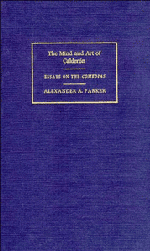Book contents
- Frontmatter
- Contents
- Author's preface
- Editor's preface
- Introduction
- I Stylistic and dramatic craftsmanship
- II From experience to myth
- III The tensions of social life
- 11 The functions of comedy
- 12 The vicissitudes of secrecy (1): La dama duende, El galán fantasma
- 13 The vicissitudes of secrecy (2): El astrólogo fingido
- 14 Secret betrothals and secret marriages: El postrer duelo de España
- 15 From comedy to tragedy: No hay cosa como callar
- 16 A Calderonian conception of tragedy: El pintor de su deshonra
- 17 The tragedy of honour: El médico de su honra
- IV The tensions of public life
- V From symbol to myth
- Epilogue
- Notes
- Index
13 - The vicissitudes of secrecy (2): El astrólogo fingido
Published online by Cambridge University Press: 05 February 2012
- Frontmatter
- Contents
- Author's preface
- Editor's preface
- Introduction
- I Stylistic and dramatic craftsmanship
- II From experience to myth
- III The tensions of social life
- 11 The functions of comedy
- 12 The vicissitudes of secrecy (1): La dama duende, El galán fantasma
- 13 The vicissitudes of secrecy (2): El astrólogo fingido
- 14 Secret betrothals and secret marriages: El postrer duelo de España
- 15 From comedy to tragedy: No hay cosa como callar
- 16 A Calderonian conception of tragedy: El pintor de su deshonra
- 17 The tragedy of honour: El médico de su honra
- IV The tensions of public life
- V From symbol to myth
- Epilogue
- Notes
- Index
Summary
Whether the characters in Spanish plays are strictly bound by the social conventions, or whether they observe them only loosely, marks the difference between tragedies, serious dramas and comedies. El astrólogo fingido is much more of a comedy than most of Calderón's cloak-and-sword plays, and in reading it we are at once struck by the disparity between the absurd protestations that the women make about their honour as long as they have their young men firmly on the lead, and the readiness with which they go behind the conventions if the young men threaten to abandon their attentions. The resulting intrigues are a satire on the conventions as well as on feminine protestations about honour, but as befits comedy the satire in this particular case is light-hearted. In the case of serious plays and tragedies there is nothing to laugh at: the conventions are presented in their starkness and the modern reader is repelled; whether the dramatist was also repelled and sought to arouse repulsion in his audience is what critical analysis should seek to determine. There is no such uncertainty or ambiguity in comedies. El astrólogo fingido can serve as an example of how far Calderón's humour could go in presenting the social and the stage conventions. It can also serve to demonstrate that Calderón's comedies are works of art, and not just examples of cleverly constructed intrigues.
- Type
- Chapter
- Information
- The Mind and Art of CalderónEssays on the Comedias, pp. 153 - 168Publisher: Cambridge University PressPrint publication year: 1989

